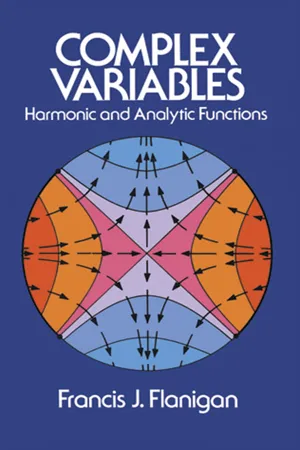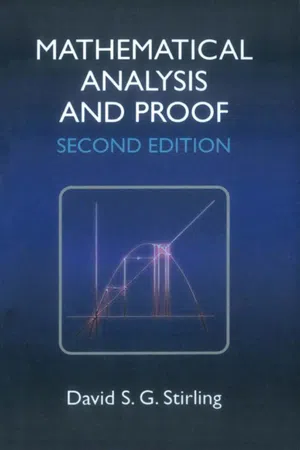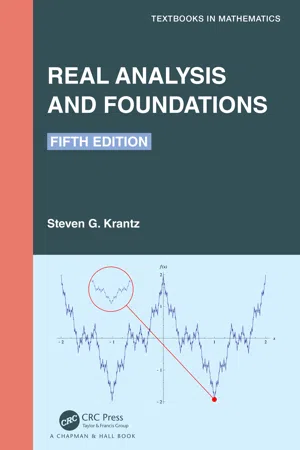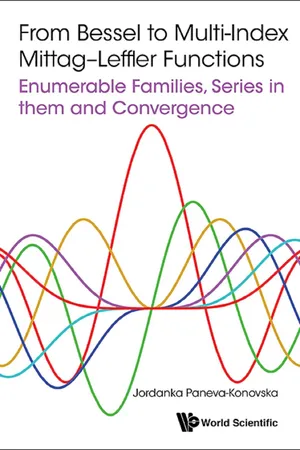Mathematics
Radius of Convergence
The radius of convergence is a concept in power series that determines the interval of values for which the series converges. It is the distance from the center of the series to the nearest point where the series diverges. The radius of convergence is determined by the coefficients of the series and can be calculated using various methods.
Written by Perlego with AI-assistance
Related key terms
Related key terms
1 of 4
Related key terms
1 of 3
5 Key excerpts on "Radius of Convergence"
- eBook - ePub
- Francis J. Flanigan(Author)
- 2013(Publication Date)
- Dover Publications(Publisher)
disc of convergence”).For The Connoisseur
The question of convergence of a series at points on the rim of the disc of convergence is a study in itself. Some elementary phenomena are treated in the exercises.How to Compute the Radius of Convergence
It is occasionally useful to be able to compute the radius R for an explicitly given power series. We will present a method that works in most cases. It depends on the Ratio Test for convergence, which is proved in most calculus texts. Let us state this test first.RATIO TESTLet ∑ b k be a real series with b k > 0, and suppose the following limit of ratios exists:Then(i) if < 1, the series converges .(ii) if > 1, the series diverges .(iii) if = 1, the test is inconclusive .We may now obtain the Radius of Convergence from the following result.THEOREM 5Given ∑ a k (z − z 0 )k , ifexists, then the series has Radius of Convergence R = 1/L if L ≠ 0 and R = if L = 0. If the limit is infinite, then R = 0.Proof: We form the ratioPutThus, the λ of the Ratio Test exists for this series if and only if L exists. Now λ < 1 if and only if |z − z 0 | < 1/L so that R = 1/L is the Radius of Convergence. Done.Examples
1. Given 1 − (z − 1) + (z − 1)2 − = ∑ (−1)k (z − 1)k . Thus, a k = (−1)k for all k and so L = 1. By the theorem, R = 1.We might verify this in another way. We note thatby our work with geometric series. Removing the brackets, we see that 1/z = 1 − (z − 1) + (z − 1)2 − (z − 1)3 + . Thus, the given series is actually an expansion of the function f (z ) = 1/z in powers of z − 1. But this function “blows up” at z = 0 only, and so we might expect that a disc of convergence centered at z 0 = 1 would extend only to the origin. That is, R = 1, as found above by the theorem.2. Given the series ThenThus, the limit L as k gets large is zero, and so R = - eBook - ePub
- Konrad Knopp(Author)
- 2012(Publication Date)
- Dover Publications(Publisher)
r is the circle of convergence. The behavior of power series on the boundary of the circle of convergence can be quite varied, as the following three examples show.Σz ν has r = 1 ; the series is divergent at every boundary point (i .e ., for every z with |z | = 1).also has r = 1 (why?); the series, however, is absolutely convergent at every boundary point.likewise has r = 1. The series is divergent at z = + 1, convergent at z = –1.We shall sketch a second proof of the fundamental theorem concerning the existence of a definite circle of convergence for every power series, which, however, does not yield simultaneously a formula for the radius itself.To this end we first prove: 1) If Σaν zν converges at z = z 1 ≠ 0, then the series is absolutely convergent for every z for which |z | < |z 1 | (in other words, for every z lying in the interior of the circle that passes through z 1 and has 0 as center). For if z is a fixed point of this kind, then . If we denote by K an upper bound of the null sequence , and denote the proper fraction by θ, then , and consequently Σaν zν is absolutely convergent, as asserted.Equivalent to this is: 2) If Σa ν z ν diverges at , then the series is divergent for every z for which , in other words, for every z whose distance from the origin is greater than that of .If, now, Σaν zν converges neither everywhere nor nowhere (except at 0), then there exists a point of convergence z 1 ≠ 0 and a point of divergence . According to the two preliminary remarks, it is therefore possible to assign a positive number r 0 (<|z 1 |) such that the series converges for z = r 0 , and a positive number I such that the series diverges for . We now apply the bisection method to the positive real interval . We designate its left or its right half as J l , according as Σaν zν diverges or converges at the midpoint . According to the same rule, we designate the left or the right half of J 1 as J 2 , etc . The intervals J ν then all have the property that our power series converges at the left endpoint r ν of J ν , but diverges at the right endpoint . The (positive) number r determined by this nest of intervals is the Radius of Convergence of the series. For if |z | < r, then there exists anrνfor which . Hence, by the first preliminary remark, Σaν zν is convergent, because z lies closer to the origin than r ν does. If |z ′| > r , then there exists an with , and since our series diverges at , it also diverges at z - eBook - ePub
- David S G Stirling(Author)
- 2009(Publication Date)
- Woodhead Publishing(Publisher)
n .The first thing to recall is the result of Lemma 8.11, that if the power series ∑ a n w n converges, then ∑ a n x n converges if |x | < |w |. We make this systematic:Definition The power series ∑ a n x n is said to have Radius of Convergence R if it converges for all real x with |x| < R and diverges for all real x with |x | > R .(Notice that nothing is said about x = ± R .)Theorem 12.1 A power series ∑ a n x n either converges for all x ∈ or has a Radius of Convergence.Proof : We introduce the set A = {x ≥ 0: ∑ a n x n converges}. The two cases arise according as A is bounded above or not.Suppose A is bounded above. Since A is non-empty (0 ∈ A ), it has a supremum; call it R . We show that R is the Radius of Convergence.Let –R < x < R . Since |x | < sup A ∃w ∈ A with |x| < w . Then since ∑ a n w n converges, Lemma 8.11 shows that ∑ a n x n converges absolutely. Thus, for all x ∈ (–R , R ) ∑ a n x n converges.Now let x ∈ with |x | > R . Then ∑ a n x n must diverge, for if not, let y = (|x | + R )/2 so that |y | < |x| and by Lemma 8.11 ∑ a n y n would converge, giving y ∈ A and y > sup A = R , a contradiction.For the remaining case, suppose A is not bounded above. Let x ∈ . Then |x| is not an upper bound for A , so ∃w ∈ A such that w > |x |, whence Lemma 8.11 proves that ∑ a n x n converges. Since x was arbitrary, we have shown that the series converges for all x ∈ . - eBook - ePub
- Steven G. Krantz(Author)
- 2022(Publication Date)
- Chapman and Hall/CRC(Publisher)
open interval of convergence.It happens that, if a power series converges at either of the endpoints of its interval of convergence, then the convergence is uniform up to that endpoint. This is a consequence of Abel's partial summation test; details will be explored in the exercises.Example 9.2: Consider the power seriesWe may apply the Root Test to this series to see that∑j = 1∞.2 jx j=|a j|1 / j= 2||2 jx j1 / j| x |.This expression is less than 1 precisely when. Thus the open interval C of convergence for this power series is| x |< 1 / 2( − 1 / 2 , 1 / 2 ). We can easily check by hand that the series does not converge at the endpoints.□On the interval of convergence C , the power series defines a function f . Such a function is said to be real analytic. More precisely, we haveDefinition 9.3: A function f , with domain an open setU ⊆ ℝand range either the real or the complex numbers, is called real analytic if, for eachc ∈ U, the function f may be represented by a convergent power series on an interval of positive radius centered at c :f ( x ) =∑j = 0∞.a j( x − c )jExample 9.4: The functionf ( x ) = 1 / ( 1 +is real analytic on the intervalx 2)( − 1 , 1 ). This is true because1=1 +x 2∑j = 0∞.( −jx 2)In actuality, f is real analytic on the entire real line. But it requires power series centered at points other than the origin to see this. The entire matter is best explained in the context of complex variables, and this point of view is explained below.□ - eBook - ePub
From Bessel To Multi-index Mittag-leffler Functions: Enumerable Families, Series In Them And Convergence
Enumerable Families, Series in them and Convergence
- Jordanka Paneva-Konovska(Author)
- 2016(Publication Date)
- WSPC (EUROPE)(Publisher)
, such a relation does exist (see for details [Markushevich (1967, Vol. 1, Chapter 3, p. 357, §7, 7.3)]), namely, as follows.Theorem 3.3 (of Fatou). If the coefficients of the power series with the unit disk of convergence tend to zero, i.e. limn→∞an = 0, then the power series converges, even uniformly, on each arc of the unit circle, all points of which (including the ends of the arc) are regular for the sum of the series.Recall that it is possible for a given power series with a finite Radius of Convergence 0 < R < ∞ to be convergent or divergent at some points of the boundary C(0; R). These points could be regular or singular for its sum f, but the series diverges outside the domain of convergence. However, sometimes it is possible for a subsequence of its partial sums to exist that converges in the neighborhood of a regular point of the sum. In order to introduce the next definition ([Markushevich (1967, Vol. 2, p. 500)]), we first setDefinition 3.3. A power series with a finite Radius of Convergence R is said to be overconvergent, if there exist a subsequence of the partial-sums sequence and a region G, containing the open disk D(0; R), G ∩ ∂D(0; R) ≠ ∅, such that {spk} is uniformly convergent inside G.Definition 3.4. We say that the function f (or the series), given by (3.8), possesses Hadamard gaps, if there exist two sequences and , having the property qn−1≤ pn ≤ qn /(1 + θ)(θ > 0) and ak = 0 for pn < k < qn (n
Index pages curate the most relevant extracts from our library of academic textbooks. They’ve been created using an in-house natural language model (NLM), each adding context and meaning to key research topics.
Explore more topic indexes
Explore more topic indexes
1 of 6
Explore more topic indexes
1 of 4




